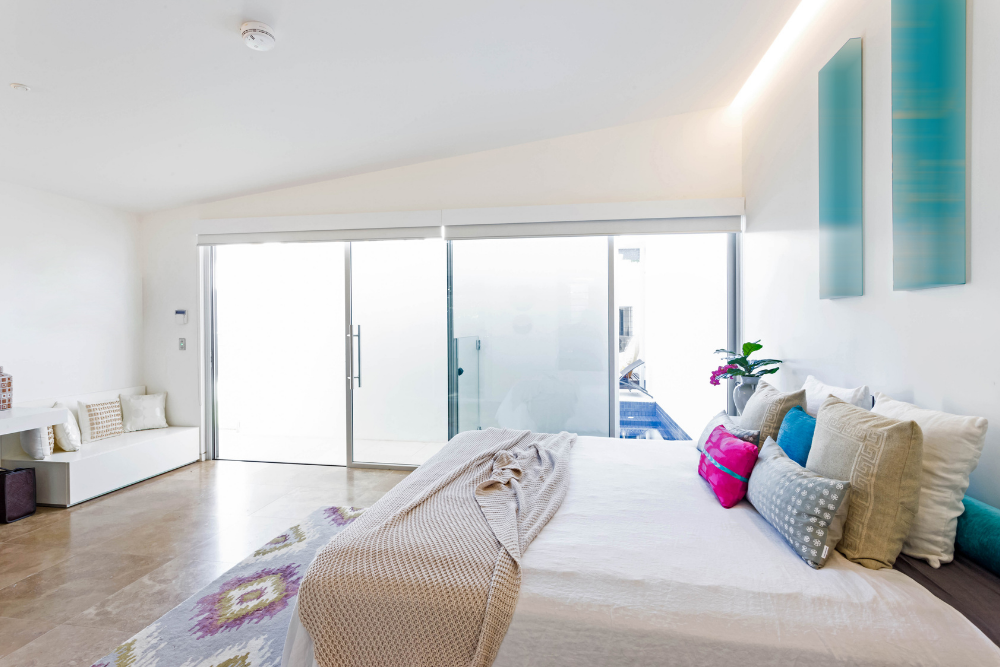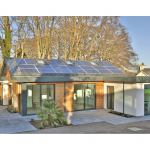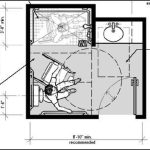The introduction of a chronic condition into your world can cause your lifestyle, career, and relationships to revolve around a whole new set of priorities. You might feel overwhelmed as you try to navigate what to do next — and wonder how to prepare for what’s coming down the road.
A large part of “what comes next” lies in your own house. For those living with chronic conditions, remaining at home is the best option — it is possible to meet your long-term care needs while still maintaining your comfort and quality of life.
Of course, most people don’t have a home that is particularly suited for someone with a disability or medical condition.
Maybe you have stairs, or uneven flooring. Even high cabinets or a typical bathtub where climbing in can be problematic if you are living with an illness.
Here’s the thing, though: in the vast majority of cases, these are issues that can be solved with a bit of interior design creativity.
Even better, many of the changes you can make to your home are more cost-friendly options, especially considering the alternatives – i.e. moving into an assisted living or long term care facility.
Does this sound intimidating or difficult to do? Live in Place Designs can help.
We’re CAPS-certified. And we combine our home design, architecture, and healthcare knowledge with your personal needs, desires, and medical circumstances to give you the residential support that you need at this time in your life.
The Live in Place Design Process
We start with a customized investigation of your health and lifestyle as it is. One of our specialists will walk you through an average day.
How you perform your morning toiletries? Do you make coffee or breakfast for yourself? Where do you spend the majority of your day? What do you spend your time doing?
How do dinner, winding down, and nighttime routines go? How does bathing work for you? These are the challenge areas that we want to solve through our design process.
This touches on the key advantage of home design for chronic illness: individualization.
Each person experiences the progression of a chronic condition differently. At home, you can modify each aspect of your setting to fit your specific needs and situation. You can also make changes to your home space with your personal prognosis in mind.
At each step of the way, we’ll take note of the challenges that you experience on a regular basis. Then, after grasping your current health situation, we make a reasonable projection of how your condition is likely to progress in the long-run.
Because aging in place remodeling projects cause a certain amount of upheaval, we strive to incorporate present and future needs in our design, so that you only need to go through the decision, waiting, and cost of construction once.
What Are Some General Considerations in the Design Process for Chronic Diseases?
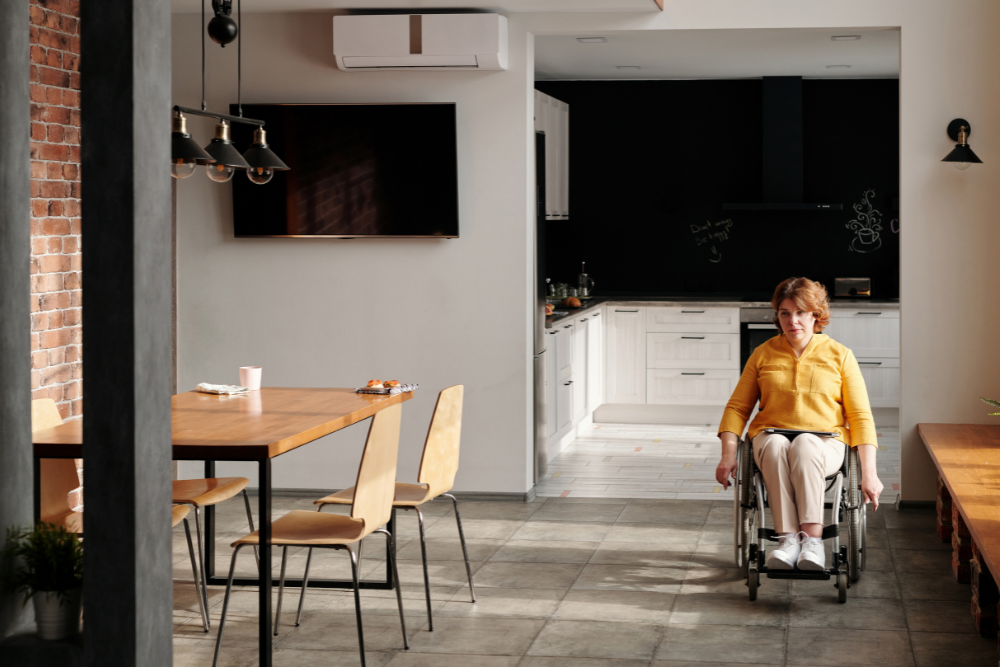
First and foremost, each design suits the individual. However, we also keep in mind the following when creating a living space for a person with a chronic condition.
Go beyond the ADA
ADA compliance is a great first step to help public spaces be more accessible and inclusive. In a home environment, however, we want to take our design approach farther than ADA guidelines. At times, we might even need to contradict them, depending on the challenges that a particular individual faces.
For instance, ADA guidelines might recommend installing a ramp to the front entryway of a house. But keep in mind that people with a condition such as Parkinson’s Disease who use a walking aid will most likely employ a 4-wheeled walker. This can make the journey down a typical ADA ramp dangerously speedy! To address this, we would modify the grade of the ramp to be less steep than ADA compliance recommends.
Equipment
The right technology and equipment additions can vastly improve the life of someone with a chronic illness. However, many homes were built with narrow hallways and doorways – or the furnishings create a compartmentalized space that can be difficult to maneuver with a walker or wheelchair.
Basically, most houses need some adjustments to make space for new assistive equipment, technology, and caretaking people. To create an optimal space for each individual in the long-run, we design for present equipment and future assistive needs.
Pain Management.
The majority of chronic conditions involve some kind of pain management. Even for those that don’t require physical pain management, the individual may still deal with physical sensitivities or psychological distress.
How does this work in specific cases, with specific features and materials built into the design?
Here are a couple of examples:
- A person with arthritis could find pain relief plus relaxation from a warm bath.
- A person on the autism spectrum may need noise-muting materials to manage auditory sensitivities.
In all cases, we design to support the consistent need for assistance while fostering the maximum amount of independence.
Holistic Approach
We incorporate the functional goals of physical and occupational therapy, but we want to serve the whole person as well. An individual living with progressive illness needs psychological and emotional support from their space – not just utility.
Part of that is helping them partake in the pleasures that they enjoy. To that end, we not only ask questions about their current life, but also what things were like pre-illness.
In other words, we want to know about hobbies, jobs, interests, favorite places, pastimes, and close relationships. And we want to bring those elements into the space where we can.
For example, we might create a comfortable “visitor nook” adjacent to someone’s bedside so that friends and family can easily stop by.
It’s fairly simple to make space in the bedroom design for this purpose, perhaps reserving a corner near the bed. And it’s easy enough for the homeowner to fill this space as they like – perhaps with a small sofa, coffee table, lamp, and a houseplant – but the degree of comfort and joy from being able to host is large.
Biophilic Design
This subset of holistic design places an emphasis on bringing the outdoors inside. In extreme examples, a house might be constructed around a live tree. But even simple renovation projects can incorporate biophilic elements.
For instance, the addition of skylights and large, open windows can illuminate a space with mostly natural light. You can also use natural textures in building materials where possible: stone, sand, river rocks, or wood.
If it’s possible to install a green wall, great; if not, lean on the classic, humble houseplant to green up your space. The mental health benefits will abound.
Aesthetics
As another part of holistic design, we want to create or maintain your preferred look. We use style guides, color swatches, hardware samples, and even Pinterest to help guide our clients to a design that works for them and feels comfortable – even inspiring.
In short, “functional” doesn’t have to mean “sterile” or “clinical”. Universal design principles allow us to design a floor plan of the space for everyone without highlighting one person’s disability in the look or feel of the design.
The beauty of this: we de-emphasize disability and emphasize ability.
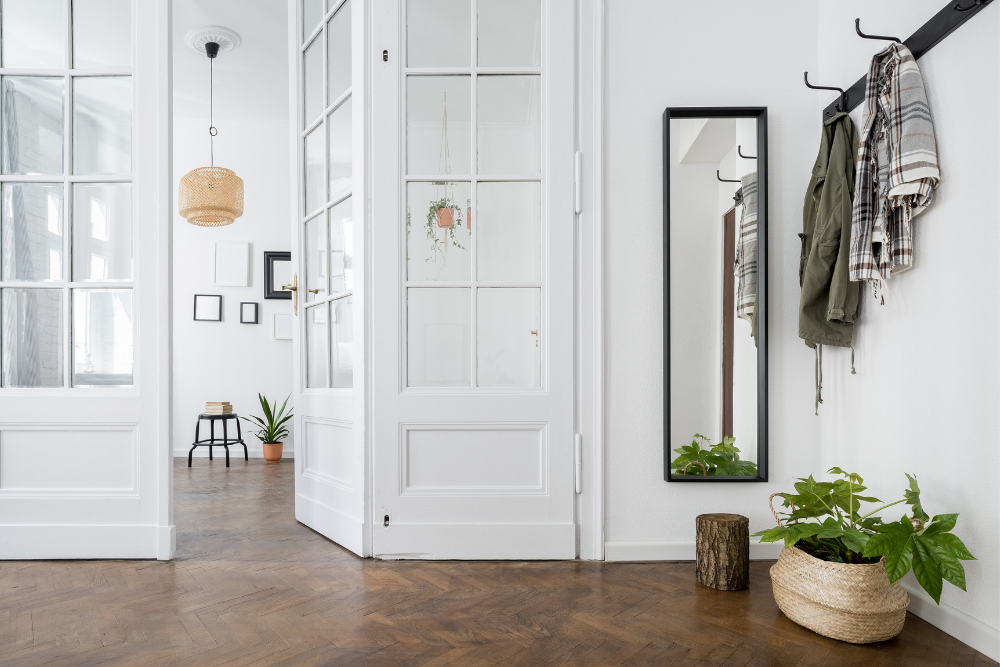
What Design Looks Like for Common Chronic Conditions
These examples likely have you asking an important question: how do we address different chronic illnesses with design?
Since the process is so individualized, it’s easiest to illustrate this by using a handful of common chronic illnesses. We’ll go through six common ones, and we’ll provide specific examples to illustrate how we handle design projects addressing these conditions.
Arthritis

You’ve likely heard many aging people complain of some arthritis in their fingers or knees. This swelling of the joints, is a chronic condition and, can actually occur in people of many ages for a variety of reasons, from wear-and-tear to autoimmune issues.
Home modifications for arthritis might involve:
- Counters and appliances at heights that reduce bending
- Plentiful space and chairs to carry out everyday tasks seated – including in the shower
- Grab bars at key locations in the house
- Slip mats in any trip/fall hazard areas – and removal of loose carpet or throw rugs
- Ergonomic and lightweight kitchen tools
- Bath tub for warm soaks that soothe the joints
Arthritis manifests on such a spectrum that it’s particularly important to individualize these designs. Someone only suffering from carpal tunnel might need home office modifications, whereas someone with full-blown rheumatoid arthritis might need an entire care-facilitative system at home.
Dementia/Alzheimer’s
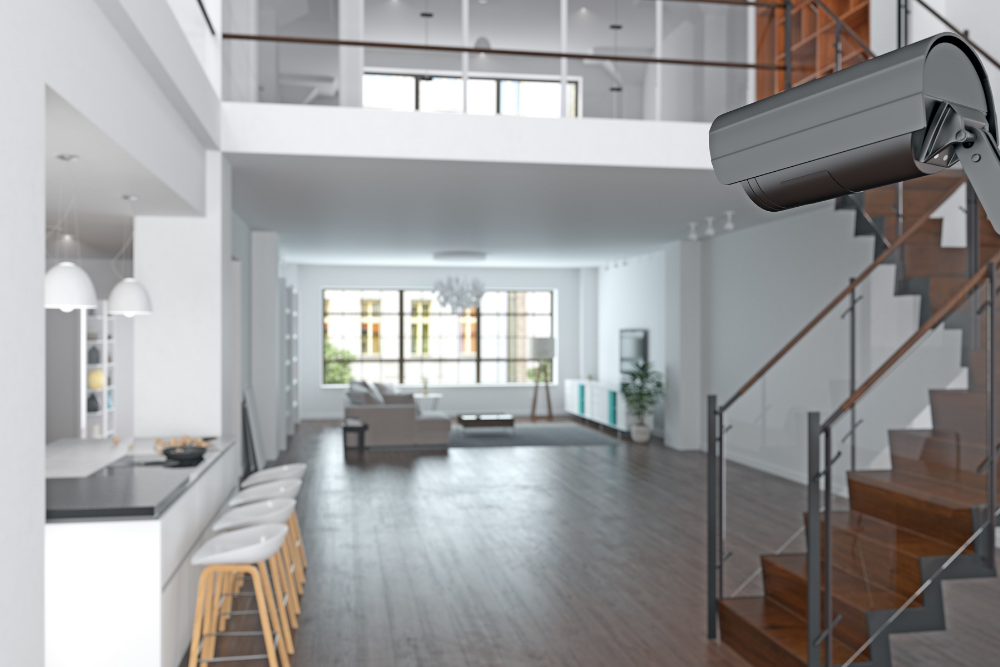
Dementia and Alzheimer’s are often mentioned in the same breath, and there is some overlap. Dementia describes a general cognitive decline due to damaged brain cells, whereas Alzheimer’s comprises a specific neurodegenerative disease that commonly causes dementia.
People with dementia and Alzheimer’s progress through many stages of ability. Someone may be able to remember most relevant information in year one, but by year seven, they may be too disoriented to safely cook or clean for themselves. Home changes with the late stage in mind can incorporate a tiered approach.
For a person with early-stage dementia or Alzheimer’s, you might consider:
- Incorporating a surveillance system to monitor care and ensure safety
- Just as important – hanging framed pictures of family members (also labeled)
- Replacing opaque cabinet doors with more transparent glazed or glass doors
- Smart appliances for safety, like a stove that turns off after a period of disuse
- Adequate lighting in the space to reduce the risk of falls, which addresses vision changes associated with dementia
- Making the home more recognizable from the exterior (i.e. painting it a bright color, planting plants the emit a distinctive aroma) and adding door alarms to alert for wandering behaviors
For the later stages of dementia or Alzheimer’s, you’ll want to plan for the presence of round-the-clock caretakers. We like to create a separate space for caretakers to rest and take breaks. This could include comfortable chairs, a small bed or cot, and a kitchenette.
Keeping the caretakers themselves replenished and respecting their privacy is an often overlooked aspect of designing for home healthcare.
Amyotrophic Lateral Sclerosis (ALS)

Amyotrophic lateral sclerosis (ALS) affects the brain and spinal cord. Gradually, motor neurons die, weakening the connection between the brain and the muscles. The terminal prognosis for this neurodegenerative disease tends to be 3-5 years, although some do live for a decade or more after diagnosis.
People with ALS who live at home might benefit from:
- An all-encompassing master bedroom suite – bed, bath, and kitchenette
- Windows to bring in natural light and the outside world, which is especially important for someone who is bed-bound
- Spacious, accessible shower with transfer chair or lift system in handicap accessible bathroom
- No bathtub – staying in warm water for long periods of time is detrimental to someone with this condition
Until there is a cure for ALS, interior design renovation needs to include the end goal of creating a comfortable space for comforting hospice care.
Multiple Sclerosis (MS)

Multiple Sclerosis (MS: Your Questions Answered) is an autoimmune disorder that affects the brain, spinal cord, and optic nerve. Inflammation causes damage to the myelin sheath, which coats nerve fibers. This confuses messages in the central nervous system.
Depending on how it develops, these design points may be supportive:
- Clustered “activity centers” throughout the house where you can sit and easily reach all the materials you need for work, chores, or hobbies
- Accessible bathtub for soaking in cool water – this helps with pain relief
- Widening doorways, hallways, and the space between furniture to make way for a walker or wheelchair
- Evaluate your “easy reach” zone and try to put most household items there; this may include lowering countertops and appliances or raising outlets
- Installation of attractive grab bars in useful locations, like the bathroom, entry, or kitchen
- If vision is affected, level out the lighting in your home to avoid abrupt transitions between brightness and darkness
Because the central nervous system covers so much, MS can manifest in a variety of ways. Home modifications need to be especially tailored to the individual’s abilities and progression.
Multiple Sclerosis: Work from Home with Smart Design
Living with Multiple Sclerosis: Quick Fixes and Long-Term Home Modifications
Parkinson’s Disease

Like MS and ALS, Parkinson’s affects motor skills through chronic and progressive neurodegeneration. What sets it apart is the specific brain cell loss that causes it, which ultimately reduces dopamine levels in the brain. This leads to characteristic loss of movement regulation, resulting in issues such as tremors, rigidity, slow movement, or trouble balancing.
When designing to support a person with Parkinson’s Disease, we might add the following features:
- Lever door handles and pull drawer handles that are easier to manipulate than knobs
- Bathtub to manage pain with warm water (note that this is the opposite of MS)
- Designated bathroom workstation to help a caretaker stay organized
- Smooth, open, trip-hazard free flooring, including a zero-entry shower
- Lowered counters so that everyday tasks can be performed while seated, with the similar goal to MS and ALS of conserving energy
Essential Home Changes & Gadgets for Parkinson’s
Autism and Sensory Processing Disorder
Although Autism and Sensory Processing Disorder are not the same condition, they do share similar sensitivities to light, sound, and touch.
Personalized home design can help an individual with either of these conditions to stabilize amid these sensitivities. Consider the following modifications:
- Compartmentalizing the home into distinct zones that serve different purposes. (i.e. therapy room, exercise space, TV/leisure nook, extra-quiet sleeping area)
- Motion detector lighting to help with things such as fear of the dark and risk of falls due to impulsive behavior
- Incorporating color therapy. Often, neutral colors or peaceful blues and greens may work best
- Doorbell monitoring systems and other smart technologies to increase a sense of controlling one’s environment
Your Guide to Best Home Modifications for Autism and Sensory Processing Disorder
Get Started in Using Design to Help You Live well with Chronic Conditions
As you can see, no matter what chronic illness is impacting your life, there are design elements that can be used to minimize its negative effects and make your living space easier to navigate.
There are many different risk factors that can affect older adults, including physical activity, medical illness, and health outcomes. Physical health can be affected by things like obesity and heart disease, while mental health can be impacted by conditions such as dementia and depression. It is important for older adults to be aware of these risk factors and take steps to reduce their impact on overall health.
We know the idea of renovating a home can sound frightening and exhausting, though, which is where we come in. The CAPS-certified team at Live in Place Designs has helped countless others to improve their space so that they can continue to live at home, and we can use our knowledge and experience to aid you as well.
If you’re ready to learn more, get in touch today!

